You're using an outdated browser. Please upgrade to a modern browser for the best experience.
Please note this is a comparison between Version 2 by Camila Xu and Version 1 by Leandro Flórez Aristizábal.
Implementing Collaborative Learning (CL) activities to support the education of children is something that must be carefully designed to achieve the desired goals since just having a group of children working on the same activity does not guarantee proper collaboration. It is something that goes from defining the profile of the students to structuring the collaboration according to the learning objectives, the number of children per group, roles defined, and shared resources among others.
- Computer-Supported Collaborative Learning
- deaf children education
1. Introduction
Collaborative Learning (CL) is an umbrella term for a variety of educational approaches the main purpose of which is to allow students to join intellectual efforts by working in groups and taking advantage of one another’s skills or knowledge, mutually searching for understanding or solutions [1,2,3][1][2][3]. This approach has been shown to benefit learners at many levels (social, academic, and psychological) [4] as long as it is applied in carefully designed environments for this purpose [2]. Nowadays, technological advances that make it possible for students to interact with peers despite the distance have led to a research field known as Computer-Supported Collaborative Learning (CSCL) where technology supports collaboration among learners [5]. The inclusion of ICT makes CL processes more effective as it facilitates students’ work and gives them independence; CL activities also become more engaging, especially for children [4,5,6][4][5][6].
Unfortunately, designing these types of activities to promote CL among children is not as easy as just grouping learners to work on a common task; CL must be achieved not only by understanding the students, but also the situations where and how the collaboration will take place. It is also important to notice that a collaborative activity needs to include at least three aspects: equal participation, individual accountability, and positive interdependences (PI), which are at the heart of CL scenarios where learners understand that their individual success is linked to the success of every other member of the group [7]. With all these elements, an effective CL activity can be structured.
The CollabABILITY cards are structured in such a way that makes it easier to structure a CL activity as long as they are followed in the right order (defining children’s profiles, setting initial conditions, structuring collaboration, and defining positive interdependences). These cards should be used primarily by educators who know better the pedagogical aspects and different abilities of children. Designers should take part in this process since they must evaluate how the proposed CL activity may be implemented in a technological tool. The fourth set of cards (positive interdependences) is also proposed to help designers define the right game mechanics that match positive interdependences to be included in the tool and also learning mechanics defined by educators.
The cards were implemented in both, physical cards, and a digital app. They were used and evaluated by educators of deaf children using an adapted System Usability Scale (SUS) evaluation [9][8]. The prototype with a CL activity was also evaluated by deaf children through usability tests. The results show that the cards are not just usable but also helpful in designing CL activities for deaf children.
 A series of open-ended questions were asked after the SUS evaluation to give the evaluator the opportunity to express what s/he thinks about the cards, the process, the time invested during the design of the collaborative learning activity, and how these could be improved.
A series of open-ended questions were asked after the SUS evaluation to give the evaluator the opportunity to express what s/he thinks about the cards, the process, the time invested during the design of the collaborative learning activity, and how these could be improved.
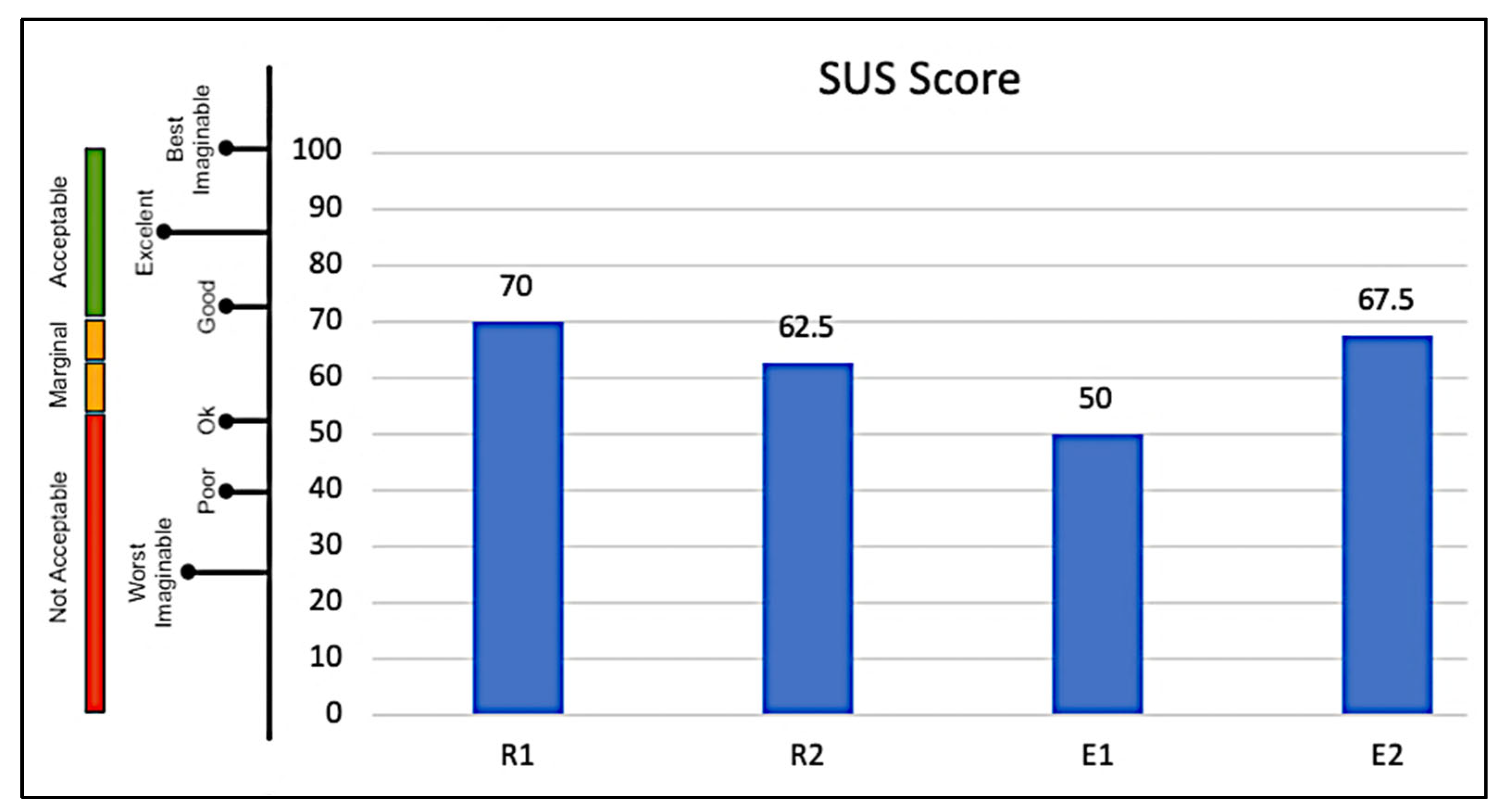
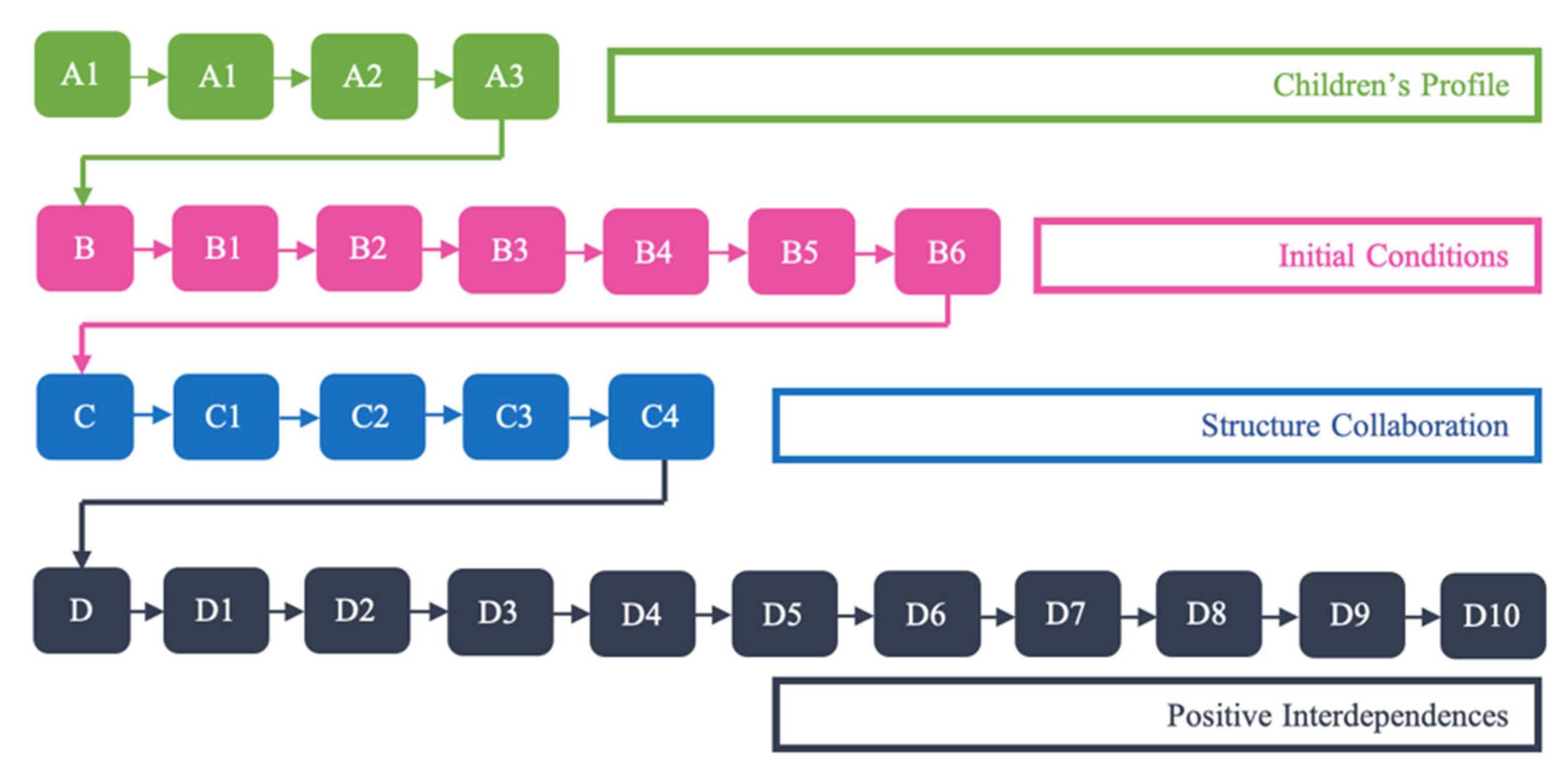 The front side of the card shows the title of the subcategory and the back side shows additional information about what has to be done during the design.
The first category is Children’s profile, tagged with the letter A, and it consists of four cards (A, A1, A2, A3). Figure 6 shows what the first category looks like (the first two cards). The front side of the card is on the left, and the back side is on the right and Table 1 shows all the details.
The front side of the card shows the title of the subcategory and the back side shows additional information about what has to be done during the design.
The first category is Children’s profile, tagged with the letter A, and it consists of four cards (A, A1, A2, A3). Figure 6 shows what the first category looks like (the first two cards). The front side of the card is on the left, and the back side is on the right and Table 1 shows all the details.
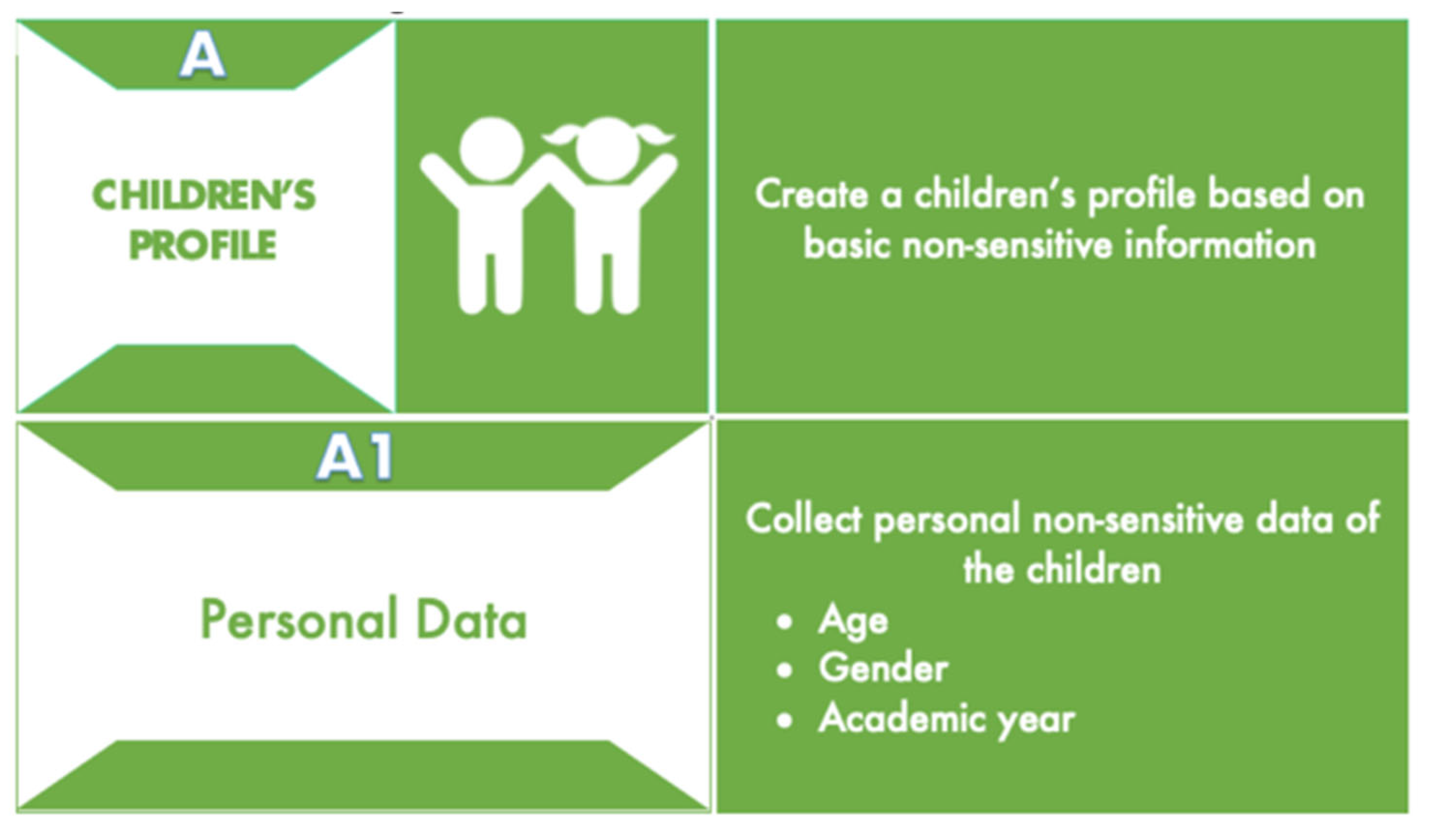
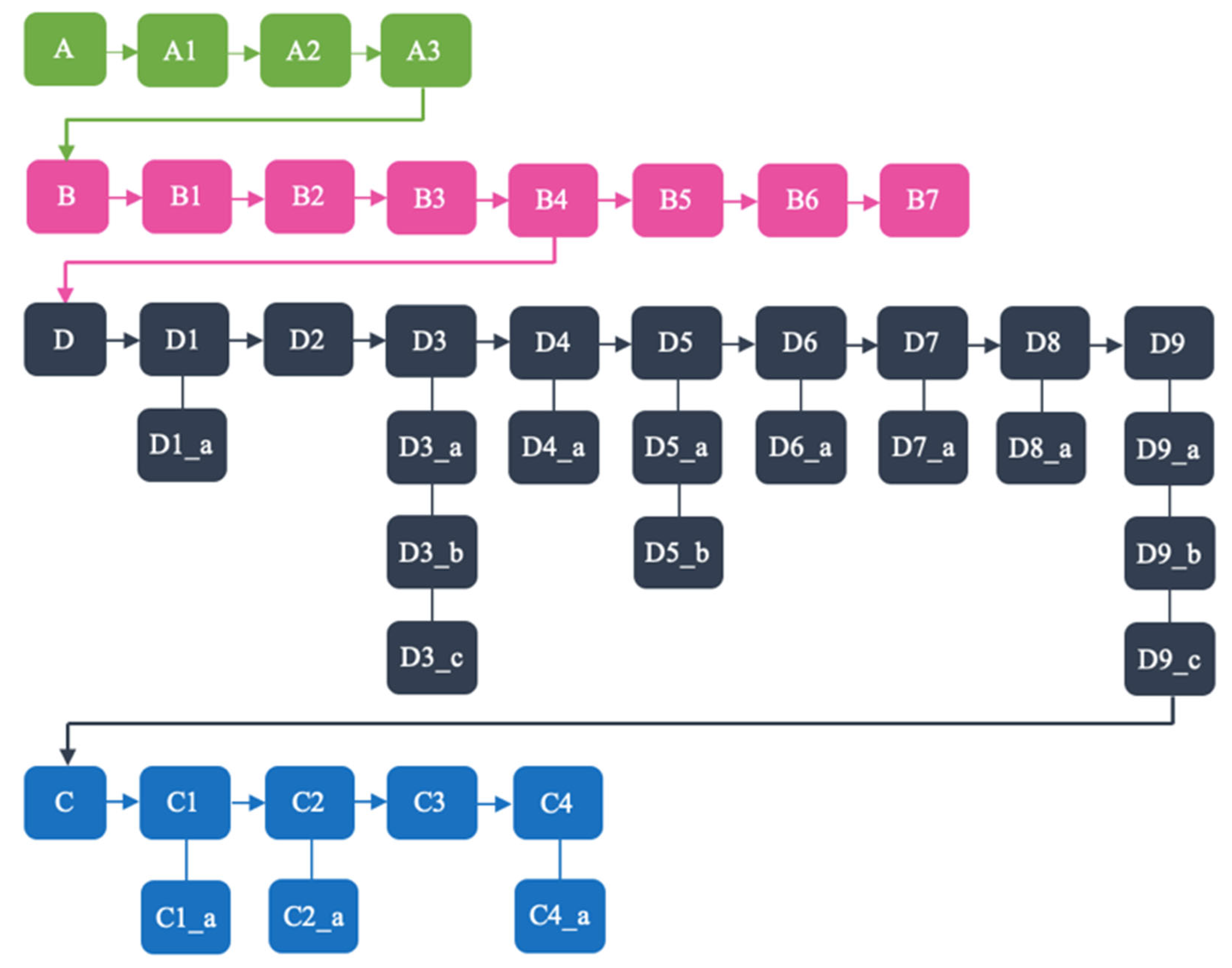 Templates were created to be used along with the cards, so the information needed during the design of the CL activity is gathered and that way has a record of every step of the design process. Only one set of cards and templates is needed per working group (designer/developer, educator).
Templates were created to be used along with the cards, so the information needed during the design of the CL activity is gathered and that way has a record of every step of the design process. Only one set of cards and templates is needed per working group (designer/developer, educator).
The second category is Initial conditions tagged with letter B and it consists of seven cards (B, B1 to B6). Figure 7 shows what this category looks like (Cards B, B1) and Table 2 shows all the details.
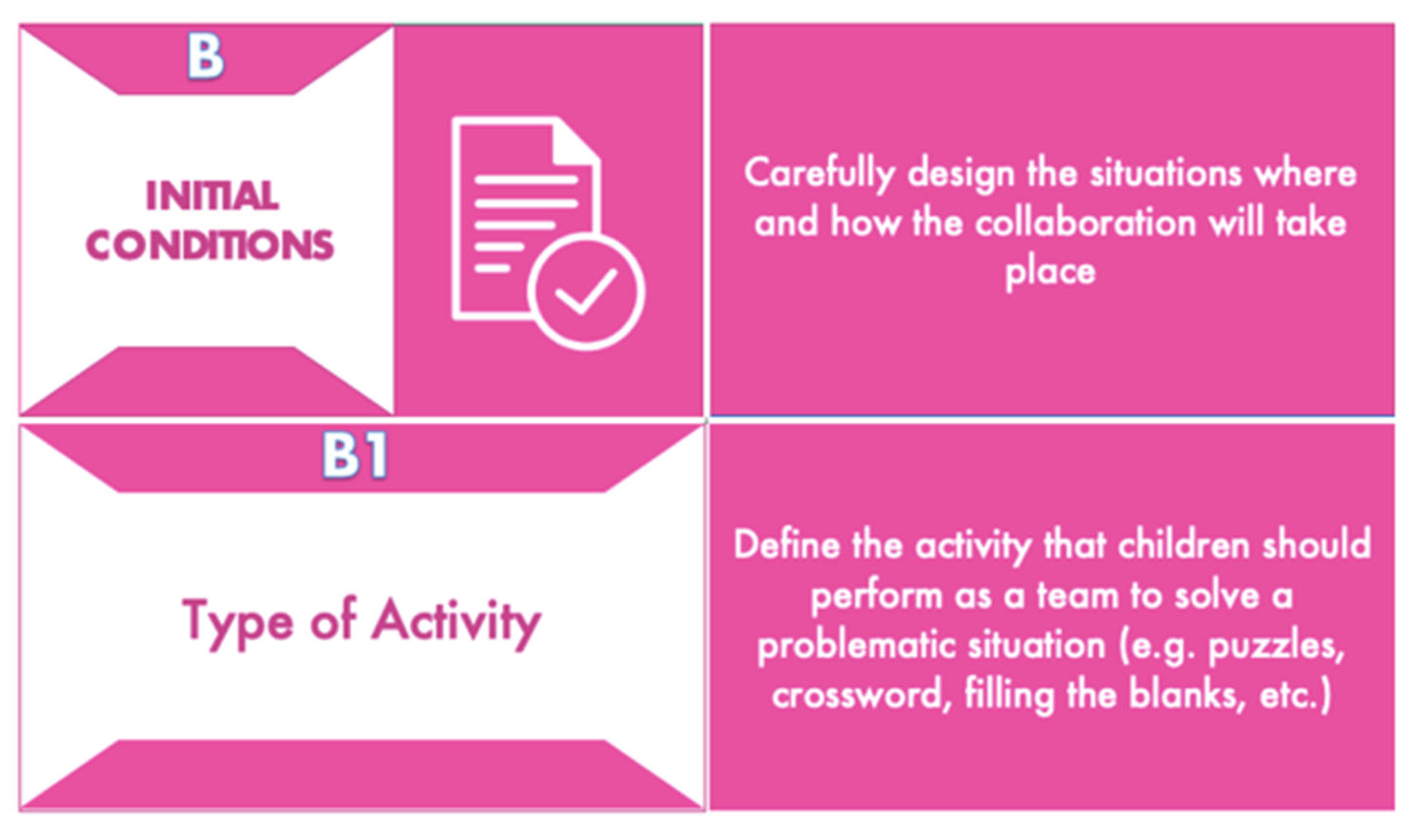
The third category is Structure collaboration tagged with the letter C and consists of five cards (C, C1 to C4). Figure 8 shows what this category looks like and Table 3 shows the details.
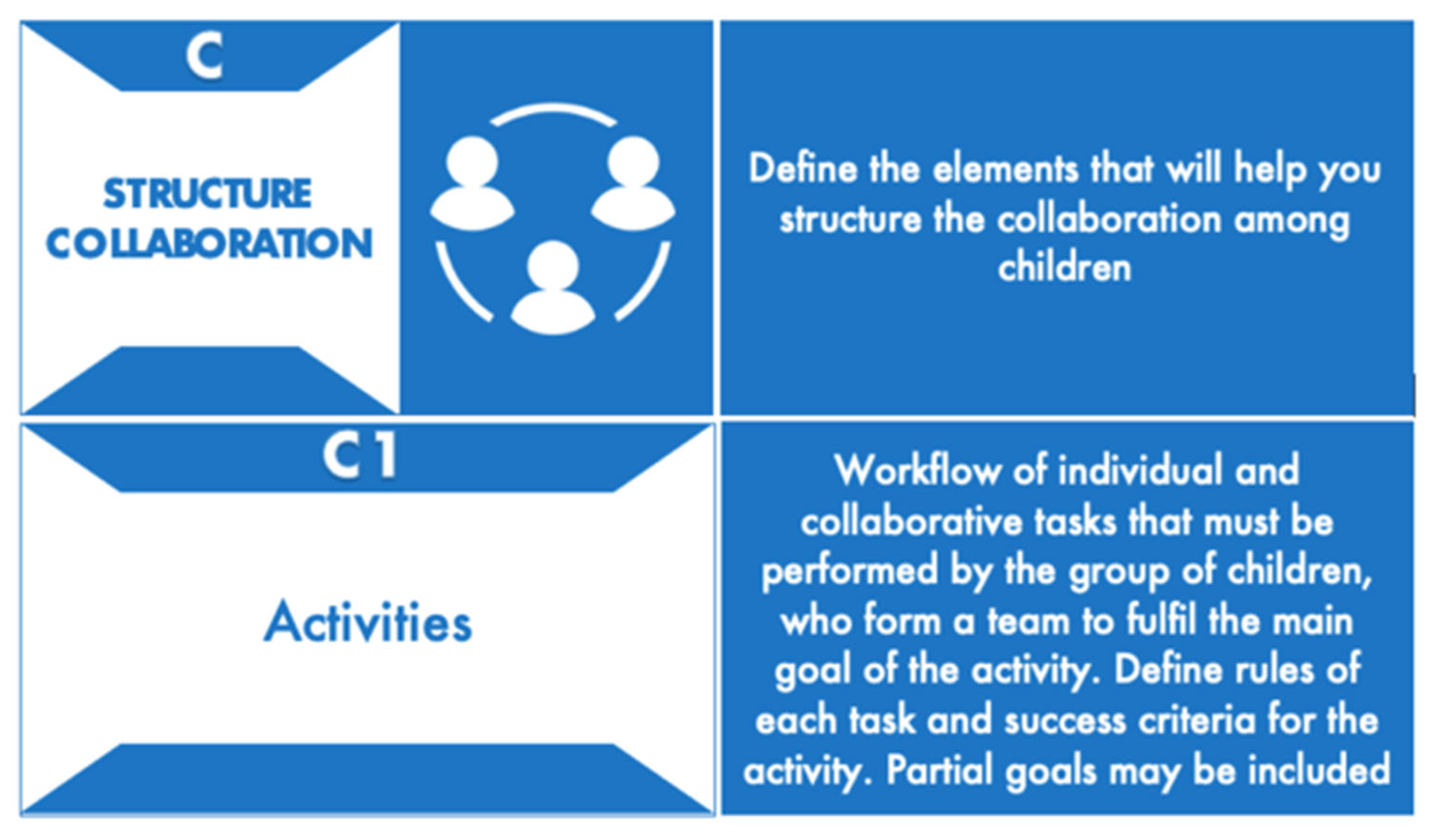
Finally, the last category was created for positive interdependences (PI). As mentioned before, PI is necessary to assure collaboration between members of a team. Johnson and Johnson [15,16,17][14][15][16] states that team members perceive that they need each other in order to complete the group’s task (“sink or swim together”). To successfully design a CL activity, 9 positive interdependences are defined and one or more can be integrated to achieve collaborative work. As part of this research, these PI were mapped [18][17] with learning mechanics and game mechanics from the LM-GM (Learning Mechanics–Game Mechanics) framework [19][18] as well as with collaborative game mechanics (CGM) from [20][19].
GM and CGM are the rules and procedures that provide interaction with a game and for CGM; these rules promote collaboration among players. LM are pedagogical practices that support learning [19][18].
From the LM-GM framework [19][18], wresearchers mapped its mechanics with the CGM given in [20][19]. Then, from collaborative learning literature, wresearchers mapped the positive interdependences found in collaborative situations [21][20] with the previous LM-GM-CGM mapping. This new mapping will allow uresearchers to determine how collaborative learning could be implemented during the design of a system along with GM and LM to increase motivation towards achieving group goals.
This last category is a great way to communicate ideas between educators, designers and developers. For instance, if an educator suggests that the activity should provide a learning mechanic such as incentive, this can be translated to a game designer language as a game mechanic such as reward/penalty which is present in all games. This can also be mapped as a positive interdependence (celebration/reward), which guarantees that the activity promotes some kind of collaboration.
This category is called Positive interdependences tagged with the letter D and consists of the following cards (D, D1 to D10). Figure 9 shows how this category looks like and Table 4 shows the details.
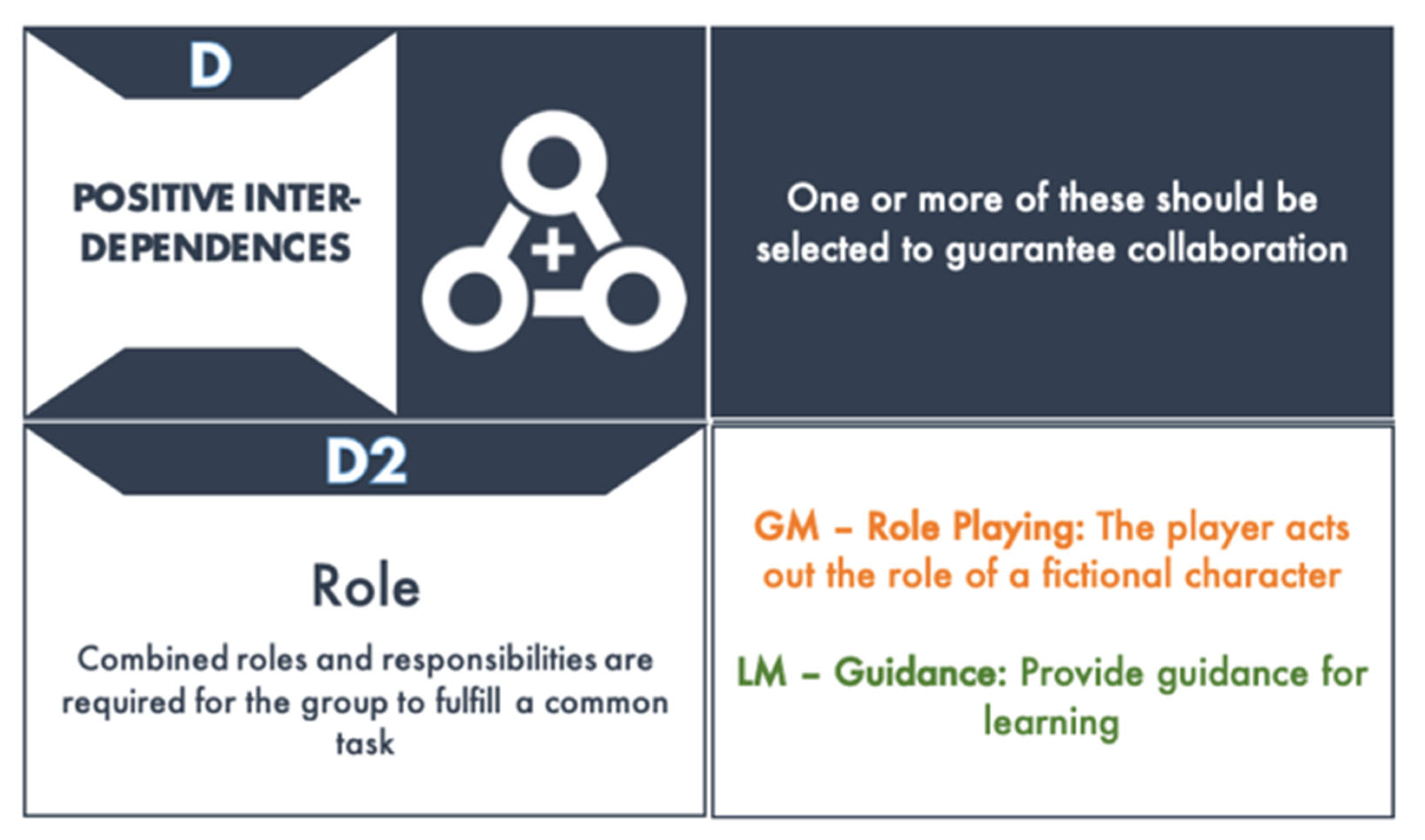

This new version of the cards is available in both physical (printed) and digital versions. The digital version is an Android app that can be downloaded from the Play Store.
 The qualitative evaluation made through the questionnaire reveals that the evaluators consider that this is actually a great resource for them, not just educators, but also researchers as it helps design collaborative learning activities that can be later integrated into a digital system.
The collaborative learning activity designed and implemented by one of the groups of experts demonstrates that co-designing this kind of activity requires an interdisciplinary team (designers and educators). All of the evaluators agreed that these kinds of resources (cards and templates) make this process easier as long as educators work along with designers as it is necessary to have a pedagogical and HCI/design/software development background.
The qualitative evaluation made through the questionnaire reveals that the evaluators consider that this is actually a great resource for them, not just educators, but also researchers as it helps design collaborative learning activities that can be later integrated into a digital system.
The collaborative learning activity designed and implemented by one of the groups of experts demonstrates that co-designing this kind of activity requires an interdisciplinary team (designers and educators). All of the evaluators agreed that these kinds of resources (cards and templates) make this process easier as long as educators work along with designers as it is necessary to have a pedagogical and HCI/design/software development background.
2. Background
The DesignABILITY framework [7] is proposed as an alternative to help designers and developers in the design of interactive collaborative tools to support teaching to children with disabilities. This framework is divided into four stages (learning requirements, design for engaged learning, prototyping, and evaluation) and it has been adapted for literacy teaching to deaf children through storytelling. For this adaptation, the design for the engaged learning stage involves storytelling and collaborative learning as strategies to motivate children and make the learning process meaningful (Figure 1). The collaborative learning sub-stage defines the steps to be followed in the design of a CL activity. In the following section, the steps to be followed are explained.2.1. Children’s Profile
Here, non-sensitive data about the children must be gathered, such as age, gender and academic year, skills/abilities, learning methods and strategies, degree of hearing impairment, school level, use of sign language or cochlear implants, interests, and language level.2.2. Initial Conditions
When the profile is defined, the situations where and how the collaboration will take place must be designed. This includes the type of activity, nature of collaborators, group heterogeneity, positive interdependences, setting of collaboration, conditions of collaboration, and period of collaboration.2.3. Structure Collaboration
The collaboration is finally structured by defining these four elements: activities, roles, communication, and shared resources. This sub-stage had been evaluated as a theoretical approach by expert reviewers in Human-Computer Interaction (HCI), designers, and software developers. Most of the reviewers agreed that even though it was well structured, they thought it could be hard to design a collaborative learning activity just by following this theoretical proposal. That is why the CollabABILITY cards and their templates were designed to make this process easier to execute. While these three stages, along with positive interdependences, are necessary and well documented in the literature [5[5][6][8],6,9], implementing all these elements in one single design is not straightforward and there is no easy path to be followed, especially by people like designers or developers of technology who are not familiar with terms like collaborative learning or positive interdependences. Moreover, this process becomes more challenging when the people you design for are children with disabilities, for instance, deafness. For these reasons, the following research question arises: How can Computer-Supported Collaborative Learning activities be designed for deaf children? To address this question, the following sections show related work that may contribute to this restudyearch, and a design approach is presented through a set of cards and templates.3. Related Work
3.1. Collaborative Learning Design
Jeong and Hmelo-Silver proposed in [5] a set of seven affordances of CSCL that address particular types of functional requirements or challenges learners experience in collaborative settings. They can be further unpacked with a number of different dimensions with different technological solutions. The affordances proposed are:-
Collaborative tasks. Learners may want to collaborate, but they need a joint task that is group-worthy.
-
Communication. For collaboration to occur, students need to be able to communicate with each other.
-
Resources. Learners often possess unique experiences and expertise that are relevant to the task. One of the advantages of collaboration is that group members can combine the relevant resources distributed across the team.
4.1.1. Evaluation of CollabABILITY Cards (Version 1.0)
Once the first version of the cards was designed, another evaluation was conducted with four experts, two of them researchers (one man and one woman between 30 and 40 years old) with an HCI/software development background from Cali (Colombia) and two educators, one of them is a school teacher of deaf children in Gourock (Scotland) and the other one is a school teacher of hearing children in Cali (Colombia), both of them women between 30 and 40 years old. They worked in pairs (one researcher and one educator) and they were asked to use the cards in the design of a collaborative learning activity. This version of the cards was evaluated along with their respective templates of every category through an adapted System Usability Scale (SUS) and a short questionnaire. The reason to use an adapted SUS was that these cards would be later implemented as a mobile app. The 10 SUS statements presented to the experts were:-
I think that I would like to use these cards/templates frequently.
-
I found the cards/templates unnecessarily complex.
-
I thought the cards/templates were easy to use.
-
I think that I would need the support of a technical person to be able to use these cards/templates.
-
I found the various functions in these cards/templates were well integrated.
-
I thought there was too much inconsistency in these cards/templates.
-
I would imagine that most people would learn to use these cards/templates very quickly.
-
I found the cards/templates very cumbersome to use.
-
I felt very confident using the cards/templates.
-
I needed to learn a lot of things before I could get going with these cards/templates.

Figure 3.
Response format for the SUS evaluation.
4.1.2. Results
The 10 statements of the SUS evaluation were presented to both researchers (R1, R2) and educators (E1, E2) and their responses are shown in Figure 4. The SUS score was mapped along with adjective and acceptability ranges proposed by Bangor et al. in [14][13]
Figure 4.
SUS Score mapped with adjective and acceptability ratings for version 1.0.
4.1.3. Discussion
After analyzing the SUS scores obtained, it is clear that the cards were not entirely usable; they reflect a marginal acceptance of usability which is not good enough for a tool that is supposed to make the design of a collaborative learning activity easier. The open-ended questions show that the cards are complex to use mainly because of the number of cards to use. On one hand, they all suggested simplifying the process by reducing the number of cards and perhaps using less jargon. They also recommended some kind of training or tutorial in order to explain how the cards must be used. On the other hand, they think that using the cards regularly would reduce the time invested in the design of an activity, that the whole concept of the cards is a great idea, and that the cards were actually helpful for them despite the complexity.4.2. Version 2.0
The cards were re-designed, dividing them once again into four categories, each category defined by a color and a letter, and each card numbered from 1 to N, where N is the last card of each category. The cards and the templates follow a fixed path during the design of a collaborative learning activity. These cards are tagged with letters from A to D and numbers in ascending order (1, 2, 3, …N). The number of cards was reduced from 43 to 27 (a reduction of 37%) by simplifying the content of each card and thus eliminating the need for complementary cards tagged with (_a, _b, _c, _d) and making the process more straightforward. The use of the templates was also simplified by reducing an element of repetition that was identified in different categories. The new path for this version of the cards goes as follows (Figure 5):
Figure 5.
Path used in the final version of the cards.

Figure 6.
Children’s profile category.
Table 1.
Children’s profile cards.
| Card | Front | Back |
|---|---|---|
| A | This is the front card of this category | Explains that a children’s profile must be created based on non-sensitive information |
| A1 | Personal Data | Shows the information to be collected (Age, gender, academic year) |
- Structuring CL processes. Learners engage in different processes and activities during collaboration. They may ask and answer questions, criticize or provide feedback, and agree or disagree with other members of the group.
- Facilitating co-construction. Collaboration, by definition, means that partners work toward a shared goal and co-construct something new.
-
Monitoring and regulation. In any kind of activity, metacognitive awareness and regulation are integral to good performance. Learners need to plan, monitor, and regulate CL processes.
-
Active learning. This is concerned with the techniques and methods that involve a student in constructive learning rather than being passive and listening to a traditional lecture.
- Forming and building groups and communities. Collaboration is a meeting of minds. For that to happen, students need to find partners or groups to work with and in which to work. Finding the right partners or groups who share the same interest as well as commitments to the task is key to the success of every collaboration.
- Student activity space. It is a virtual space with real-time capabilities where deaf members are offered a self-paced tool to acquire knowledge, view different resources, become engaged with the content, form groups, and assign different roles.
-
Technology used. E-learning technology is mostly visual and very interactive, thus fitting the deaf students’ learning style perfectly.
-
Communication. Deaf students must be urged to discuss and express their knowledge and acquired experience with their colleagues.
-
Assessment. Designing assessment activities can help deaf students to become lifelong learners and lead to effective interferences.
3.2. Collaborative Learning Tools for the Deaf
Egusa et al. [12,13][11][12] developed a collaborative/interactive learning game for a puppet show system for deaf children where two different activities were proposed, one called “Jumping” (electricity generation game) and the other called “Filling in the Blanks”. The former works by first selecting two players who stand in front of a Kinect sensor and must jump at the same time to create the electricity needed by the character of a story in the puppet show. The two players can consult each other in order to jump at the same time. Once they have jumped simultaneously for a predefined number of times, another pair of players takes over. This function encourages collaboration among players to play the game. In the second activity, the players are asked to teach the character of the story how to properly use grammar. The players are shown a sentence without a Japanese positional particle, and options of particles to fill in the blank. The results of this restudyearch show that using bodily movements encourages collaborative learning among deaf children and improves their motivation to learn grammar. Unfortunately, the study does not show how the collaborative learning activities were designed and how CL was structured. Namatame and Matsuda [9][8] developed a peer review application for art in special education for hard-of-hearing children which consists of a basic evaluation function and a direct comment function that has been implemented in a tablet PC. Through the study, researchers explored the following issues in educational and digital entertainment technology: (1) applying the peer-review learning strategy to art education and (2) establishing a collaborative learning environment for art education. It enables students to back-review the comments they received from their peer reviews, and by doing this, students also learn how to write better reviews. This kind of meta-cognitive skill would also help students learn domain knowledge and skills. They found that hard-of-hearing students enjoyed collaborative learning using the application, but just as in the previous study, this one does not give any insights about how CL was thought or structured in the design of the application.4. The CollabABILITY Cards
4.1. Version 1.0
The CollabABILITY Cards were created to support designers/developers, and educators in the design process of collaborative learning activities and tools. It is important to highlight that these are meant to be used only by them and not learners. When the theoretical part of this approach was first published, an expert review was carried out through a survey to evaluate the DesignABILITY framework [7] where one of the stages is this CL design proposal. A total of 26 researchers answered the questions of the survey, where 92.3% of them have experience with HCI, 46.2% with design, and 73.1% with software development. No deaf education educators were part of this first evaluation since it was meant to be made by the people who may use the whole DesignABILITY framework (not just the CL stage of the framework) in the design of educational tools. From a 5-Likert scale rating (where 1 is very difficult and 5 is very easy), 16 researchers (61.5%) rated this CL design approach with a score of 3, while 8 researchers (30.8%) rated it with 4, and the remaining (7.7%) rated it with 5. The average evaluation is 3.54 which means that it is not easy to design CL activities with this proposal. Reviewers had the chance to comment on their evaluation and most of them agreed that due to the extent of the information provided for the design of CL activities, it was not easy to understand and implement all the steps suggested. Based on these results, wresearchers decided to design the CollabABILITY cards to make this process easier to follow. Based on the theoretical approach presented in [7], there were 43 cards in the first version of the cards divided into four categories, and a different color was assigned to each category. These were tagged with letters A, B, C, and D and ascending numbers from 1 to N, where N is the last card of each category. Additionally, some cards that are complementary to others have a sub-tag _a, _b, _c, _d:-
Children’s Profile (A, A1, A2, A3)
-
Initial Conditions (B, B1, B2, B3, B4 -> D, B5, B6, B7)
-
Structure Collaboration (C, C1, C1_a, C2, C2_a, C3, C4, C4_a)
-
Positive Interdependences (D, D1, D1_a, D2, D3, D3_a, D3_b, D3_c, D4, D4_a, D5, D5_a, D5_b, D6, D6_a, D7, D7_a, D8, D8_a, D9, D9_a, D9_b, D9_c)

Figure 2.
Path used in the first version of the cards.
| A2 | ||
| Deafness-related information | Information such as degree of hearing loss, use of sign language, cochlear implants, etc. | |
| A3 | Learning-related information | Data about children’s skills, abilities, learning methods and strategies, school level, interests, language level |

Figure 7.
Initial conditions category.
Table 2.
Initial conditions cards.
| Card | Front | Back |
|---|---|---|
| A | This is the front card of this category | Explains that a children’s profile must be created based on non-sensitive information |
| A1 | Personal Data | Shows the information to be collected (Age, gender, academic year) |
| A2 | Deafness-related information | Information such as degree of hearing loss, use of sign language, cochlear implants, etc. |
| A3 | Learning-related information | Data about children’s skills, abilities, learning methods and strategies, school level, interests, language level |

Figure 8.
Structure collaboration category.
Table 3.
Structure collaboration cards.
| Card | Front | Back |
|---|---|---|
| C | Front card of this category | Explains that this category is about defining the elements that will help to structure the collaboration among children |
| C1 | Activities | Workflow of individual and collaborative tasks that must be performed by the group of children, who form a team to fulfil the main goal of the activity. Define rules of each task and success criteria for the activity. Partial goals may be included. |
| C2 | Roles | Each member of the group should be assigned a role during the activity with its own responsibilities. The role of the teacher must be also defined. Every member should have the opportunity to play a different role to balance the workload of the activity. |
| C3 | Communication | During the activity, members of the group should have the means to communicate and coordinate properly among themselves (either by text or sign language). |
| C4 | Shared resources | Each member of the group should be provided with the necessary resources to achieve the partial and main goals. Resources will be shared and represent the knowledge each member has to contribute to the activity and the success of the group. |

Figure 9.
Positive Interdependences category.
Table 4.
Positive interdependences cards.

| Card | Front (Positive Interdependence) | Back (Game Mechanics and Learning Mechanics) |
|---|---|---|
| D | This is the front card of this category | Explains that one or more PI should be included to guarantee collaboration. |
| D1 | Positive Interdependences (PI) Game Mechanics (GM) Learning Mechanics (LM) |
Specify the types of PI that will assure true collaboration among students and encourage them to think as “we” instead of “me”. GM (if necessary) and LM should also be specified in order to promote engagement and motivation in the learning activities |
| D2 | PI–Role. Combined roles and responsibilities are required for the group to fulfill a common task. | GM–Role Playing: The player acts out the role of a fictional character. LM–Guidance: Provide guidance for learning. |
| D3 | PI–Identity. Makes unity and cohesion, increasing friendship and affinity through a shared identity expressed upon a common logo, motto, name, flag, or song. | No GM or LM were found for this PI. |
| D4 | PI–Goal. It is the belief that each team member can reach his or her goals only when the goals of the group are met. | GM–Progression: The success is granularly displayed and measured through the process of completing itemized tasks. Example: a progress bar. GM–Goal: Sort of victory condition. Can be broad enough to encompass any method of winning, but here refers to game-specific goals. Example: Checkmate of a king in chess. GM–Cooperative play: Encourages players to work together to beat the game. There is little or no competition between players. Either the players win the game, or all players lose it. LM–Collaborative: More than one learner participates in a common learning activity to pursue a common goal. LM–Self–regulate: Focus attention on one’s own progress and cannel this towards achieving a goal. LM–Assist: Help, promote, or support an equal or companion. |
| D5 | PI–Environmental. A physical environment that unifies the members of a group in which they work. No GM were found for this PI. | LM–Situate: Position learning in the context in which it is to be applied LM–Discover: Gain understanding and solve problems by exploring/interacting with and manipulating the environment |
| D6 | PI–Resource. Each individual has only a part of the information, resources, or materials needed for his/her task. Therefore, the resources should be combined in order to accomplish the shared goal. | GM–Communal discovery: An entire community is rallied to work together to solve a problem/challenge. Immensely viral, a lot of fun. GM–Cascading information: Information should be released in the minimum possible snippets to gain the appropriate level of understanding at each point during a game narrative. GM–Resource management: The games’ rules determine how players can increase, spend, or exchange their resources (tokens, money, etc.). The skillful management of resources under such rules allows players to influence the outcome of the game. LM–Connect: Build knowledge by connecting information. |
| D7 | PI–Task. The organizing of the group works in a sequential pattern. When the actions of one group member have been accomplished, the next team member can proceed with his/her responsibilities. | GM–Turn: Segment of the game set aside for certain actions to happen before moving on to the next turn, where the sequence of events can largely repeat. LM–Master: Proceed step by step, completing learning of one aspect before tackling a more difficult/complex one. |
| D8 | PI–Outside enemy. Putting groups in competition with each other. Group members feel interdependent as they do their best to win the competition. | GM–Micro leader–boards: The rankings of all individuals in a micro-set. Often great for distributed game dynamics where you want many micro-competitions or desire to induce loyalty. Example: Be the top scorers at Joe’s bar this week and receive a free appetizer.No LM were found for this PI. |
| D9 | PI–Fantasy. Giving an imaginary task to the students that requires members to assume they are in a life-threatening situation and their collaboration is needed to survive. | GM–Narrative: Draws the players into a story within the game. Example: Zombie Run, uses narrative to make the players believe that zombies are after them. No LM were found for this PI. |
| D10 | PI–Celebration/reward. A mutual reward is given for successful group work and members’ efforts to achieve it. | GM–Achievement: Segment A virtual or physical representation of having accomplished something. Often viewed as rewards. Example: A badge, a level, a reward, points. GM–Fixed ratio reward schedule: Provides rewards after a fixed number of actions. This creates cyclical nadirs of engagement. Example: kill 20 ships, move a level up, receive a badge, visit five locations. GM–Chain schedule: Linking a reward to a series of contingencies. Example: Kill 10 orcs to be let into the dragon’s cave, every 30 min. the dragon appears. LM–Amplify: Provide learner with high output in return for little input. LM–Reward: Recognize achievement tangibly. |
4.2.1. Evaluation of CollabABILITY Cards (Version 2.0)
A new evaluation was conducted with six experts from Colombia, three of them are researchers with an HCI/software development background, two men and one woman between 30 and 50 years old, and three school teachers (educators) of deaf children in Cali (Colombia), all three women between 30 and 40 years old. They worked in pairs (one researcher and one educator) and they were asked to use the cards in the design of a collaborative learning activity. One group of experts used the digital version of the cards (mobile app). This new version of the cards was also evaluated along with their respective templates of every category through the adapted System Usability Scale (SUS) and the same questionnaire with a series of open-ended questions.4.2.2. Results
Once again, the SUS score was mapped along with adjective and acceptability ranges proposed by Bangor et al. in [14][13]. The open-ended questions show some really good comments and reviews about the cards, such as: “the underlying idea was excellent and really helped me to develop the activity” says E1; “The cards were very appealing visually. Clear font, bright colors, and pleasant to use” says R2; “I think the cards are very useful as a stimulus for the teacher to consider how collaboration can best be achieved in an activity. I think a workshop on this design process would be very useful for student teachers and for experienced teachers. I would definitely use the cards again” states E3. As a result of the activity, three collaborative learning activities were designed. Two of the activities ended as a paper prototype for desktop computers and one of them was implemented as a mobile app that was actually tested in a case study with deaf children in two Colombian educational institutions. Only the last CL activity (implemented as a mobile app) will be discussed in this study original Section 5research.4.2.3. Discussion
As can be seen in Figure 10, the usability of the cards increased greatly to an acceptable rating. Both the digital and printed versions of the cards received a high score which means that previous suggestions made by experts in the first evaluation were addressed correctly.
Figure 10.
SUS Score mapped with adjective and acceptability ratings for version 2.0.
References
- Smith, L.; Macgregor, J.T. What is Collaborative Learning? Collaborative Learning: A Sourcebook for Higher Education; Nnational Center on Postsecondary Teaching, Learning and Assessment (NCTLA): University Park, PA, USA, 1992; pp. 9–22.
- Guerrero, L.A.; Mejías, B.; Collazos, C.A.; Pino, J.A.; Ochoa, S.F. Collaborative Learning and Creative Writing. In Proceedings of the First Latin American Web Congress (LA-WEB 2003), Santiago, Chile, 10–12 November 2003; p. 7.
- Bagheri, S.; Rostami, N.P.; Pour Kivy, S.; Lahiji, E.R. Collaborative Learning, Collaborative Teaching & Autonomy: A Survey Study on English as a Second/Foreign Language. Modern J. Lang. Teach. Methods 2015, 5, 348–356.
- García, A.; Basilotta, V.; López, C. ICT in Collaborative Learning in the Classrooms of Primary and Secondary Education. Comunicar. Media Educ. Res. J. 2014, 21, 65–74.
- Jeong, H.; Hmelo-Silver, C.E. Seven Affordances of Computer-Supported Collaborative Learning: How to Support Collaborative Learning? How Can Technologies Help? Educ. Psychol. 2016, 51, 247–265.
- Flórez Aristizábal, L.; Cano, S.; Collazos, C.A.; Solano, A.; Slegers, K. Collaborative learning as educational strategy for deaf children: A systematic literature review. In Proceedings of the ACM International Conference Proceeding Series, Cancún, Mexico, 26 September 2017.
- Flórez-aristizábal, L.; Cano, S.; Brewster, S. DesignABILITY: Framework for the Design of Accessible Interactive Tools to Support Teaching to Children with Disabilities. In Proceedings of the 2019 CHI Conference on Human Factors in Computing Systems, Glasgow, UK, 4–9 May 2019; pp. 1–15.
- Namatame, M.; Matsuda, N. An application of peer review for art education: A tablet PC becomes a language for students who are hard of hearing. In Proceedings of the 2012 17th IEEE International Conference on Wireless, Mobile and Ubiquitous Technology in Education, WMUTE 2012, Takamatsu, Japan, 27–30 March 2012; pp. 190–192.
- Alsumait, A.; Fasial, M. CLTD: Collaborative learning tool for Deaf. In Proceedings of the ACM International Conference Proceeding Series, no. Marschark; ACM: New York, NY, USA, 2018; pp. 146–151.
- Schell, J. The Art of Game Design: A Book of Lenses; Morgan Kaufmann: San Francisco, CA, USA, 2008.
- Egusa, R.; Sakai, T.; Tamaki, H.; Kusunoki, F.; Namatame, M.; Mizoguchi, H.; Inagaki, S. Preparatory development of a collaborative / interactive learning game using bodily movements for deaf children. In Proceedings of the 15th International Conference on Interaction Design and Children IDC ’16; ACM: New York, NY, USA, 2016; pp. 649–653.
- Egusa, R.; Sakai, T.; Tamaki, H. Designing a Collaborative Interaction Experience for a Puppet Show System for Hearing-Impaired Children. In Proceedings of the International Conference on Computers Helping People with Special Needs, Linz, Austria, 13–15 July 2016; Springer: Cham, Switzerland, 2016; Volume 2, pp. 424–432.
- Bangor, A.; Kortum, P.T.; Miller, J.T. An empirical evaluation of the system usability scale. Usability Eval. Ind. 1996, 574–594.
- Johnson, D.W.; Johnson, R. Learning Together and Alone: Cooperation, Competition, and Individualization; Prentice Hall: Hoboken, NJ, USA, 1975.
- Johnson, R.; Johnson, D.W. Cooperation and Competition: Theory and Research; Interaction Book Company: Washington, DC, USA, 1989.
- Johnson, D.; Johnson, R.; Smith, K. Active Learning: Cooperation in the College Classroom. Ann. Rep. Educ. Psychol. Japan 1998, 1–29.
- Flórez Aristizábal, L.; Cano, S.; Manresa-Yee, C.; Collazos, C.A. Towards a Computer-Supported Collaborative Learning Approach for Deaf Children. In Proceedings of the 2018 Second International Conference on Accessibility, Inclusion and Rehabilitation using Information Technologies. AIRTech 2018, 2018, 11–12.
- Arnab, S.; Lim, T.; Carvalho, M.B.; Bellotti, F.; De Freitas, S.; Louchart, S.; Suttie, N.; Berta, R.; de Gloria, A. Mapping Learning and Game Mechanics for Serious Games Analysis. B. J. Educ. Technol. 2015, 46, 21.
- André, J.; Tiradentes Souto, V. À procura de um framework para jogos colaborativos. In Proceedings of the SBGames; Sociedade Brasileira de Computação: Porto Alegre, Brazil, 2014; Volume 2014, pp. 185–192.
- Laal, M. Positive Interdependence in Collaborative Learning. Procedia Soc. Behav. Sci. 2013, 93, 1433–1437.
More

